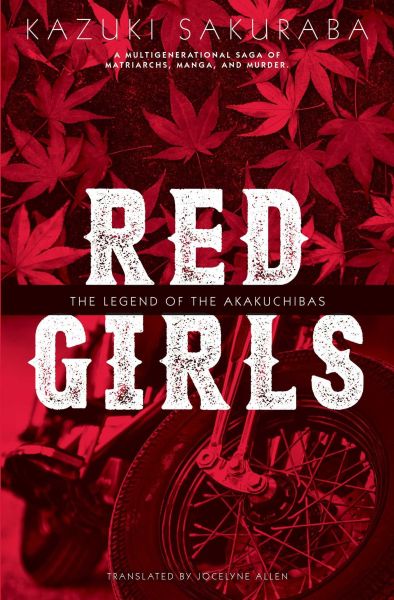A Time to Kill
Red Girls
By Kazuki Sakuraba

24 May, 2017
0 comments
Kazuki Sakuraba’s Red Girls: The Legend of the Akakuchibas was published as Akakuchibaki no Densetsu in 2006. The 2015 English language edition was translated by Jocelyne Allen.
No one would have thought that the foundling Manyo was marked for great things. A mysterious mountain-dwelling clan had left the infant in Benimidori, an insignificant rural village. Fostered by a local family, she grew up as just another rustic in a small town notable only for the old Akakuchiba iron works and some recent shipyards. But fate had other plans for Manyo.
Even as a child, Manyo had a curious knack for seeing people’s deaths. Unfortunately for the people in question and for Manyo herself, her visions were one hundred percent accurate. Once Manyo saw a future, that future was set, no matter how much the doomed might try to avoid it.
Her uncanny knack would eventually have attracted wider attention. What truly made her stand out (at least in Benimidori) was the decision of the Akakuchiba matriarch to marry off her son to the girl with the knack. The matriarch’s decision is, on the face of it, inexplicable. The Akakuchiba, the clan that runs one of the biggest businesses in the town, would seem to be too posh, too snooty, to marry their heir to a foundling without a surname. Nevertheless, that is what matriarch Tatsu wants and what the old lady wants, she gets.
Over the course of her long life, Manyo witnesses Benimidori’s evolution from a unique, if backward, town to an unremarkable exemplar of national conformity; modern telecommunications have homogenized Japan. Her knack has allowed the family as a whole to weather such vast changes … but it has not allowed her loved ones to escape death.
As Manyo is dying, she confesses that at least one death was her own handiwork. But which death was that? Manyo does not say. It is up to the grand-daughter who heard the confession, the underachiever Toko, to find out who.
~oOo~
People who know Manyo often die young. This isn’t the sort of book in which supernatural abilities are studied by scientists, so we never find out whether Manyo is simply observing that which is writ in stone or if she somehow causes the deaths by looking for them. It does seem at least arguable that there’s a significant Heisenbergian factor to her ability. What is clear is that her gift is no comfort to her, particularly where her own children are concerned.
The great mystery of Manyo’s confession is a comparatively late part of the book. Most of the book is spent setting the scene, painting a picture of Benimidori and of the Akakuchiba clan. The pace is curiously leisurely for something that takes the turn into mystery that this novel does.
Toko’s recounting of her grandmother’s life is the story of Manyo’s descendants, in particular the motorcycle-gang-leader daughter turned manga artist Kemari and her jaded, self-loathing grand-daughter Toko. It is also the story of Japan from the end of WWII, through the apparently unlimited prosperity of the 1960s to the oil shock of the 1970s, from the 1980s bubble to the lost decades that followed. Each generation is shaped by its history: it reacts against the excesses of the previous generation and falls into excesses of its own.
On learning that the world is a globe, Manyo is horrified. To her this means that people are doomed to repeat the same sad stories, over and over. This turns out to be both true and not true; each generation is a fresh variation on old themes. One would think that would ensure that this would be a sad book … and yet in the end the narrative leaves one with an oddly reassuring sense of equanimity in the midst of sorrow and change.
Red Girls is available here (Amazon) and here (Chapters-Indigo) .
Feel free to comment here.
